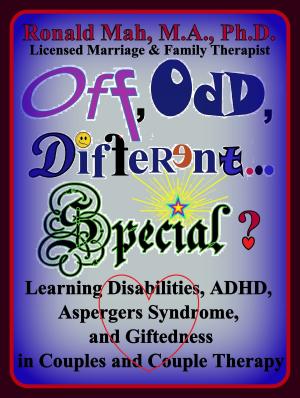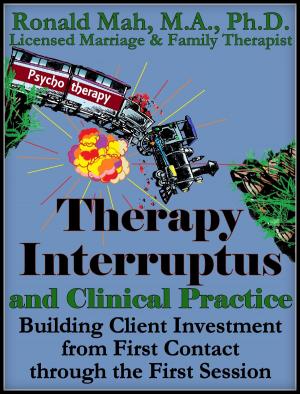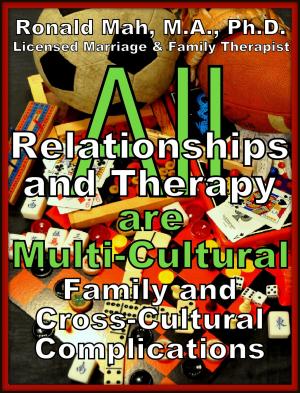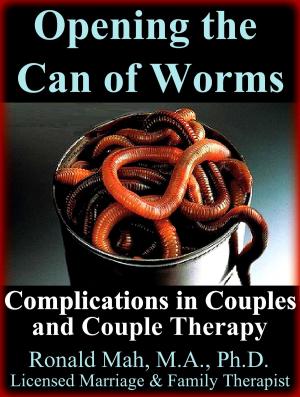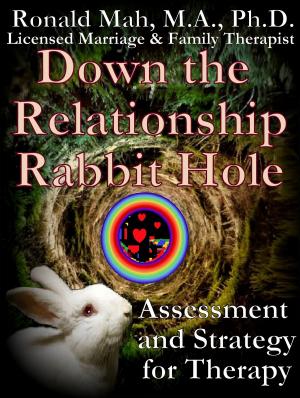Ouch! Where'd that come from?! The Borderline in Couples and Couple Therapy
Nonfiction, Health & Well Being, Psychology, Family Therapy, Counselling| Author: | Ronald Mah | ISBN: | 9781301306459 |
| Publisher: | Ronald Mah | Publication: | June 15, 2013 |
| Imprint: | Smashwords Edition | Language: | English |
| Author: | Ronald Mah |
| ISBN: | 9781301306459 |
| Publisher: | Ronald Mah |
| Publication: | June 15, 2013 |
| Imprint: | Smashwords Edition |
| Language: | English |
"Ouch! Where'd that come from?! The Borderline in Couples and Couple Therapy" addresses how the couple with a partner with borderline personality disorder challenges the therapeutic relationship in couple therapy as borderline issues and behaviors inevitably erupt simultaneously at home and in session. The therapist often considers working with the individual with borderline personality disorder among the most difficult clinical work to manage in therapy. The book explains how the couple can be the fundamental healing dynamic for the individual with borderline personality disorder. The couple therapist is guided through examination of the borderline character how to manage borderline reactivity targeted not only at the partner but also at the therapist. The therapist is prompted to attend to his or her feelings and instincts provoked by the individual- that is, counter-transference for assessment and direction for treatment. This includes borderline, partner, and therapist vulnerability desires to be "special." For the partner and the therapist, this leads to lack of preparation when naively traipsing among borderline traps hidden in the relationship, subsequent emotional, psychological, and relational injury- "Ouch!", and the shocked question of "Where'd that come from!?"
The existential trinity of the individual with borderline personality disorder: betrayal, abandonment, and rejection (B-A-R) direct the partner and therapist response trinity: caring compliance, intimacy, and acceptance (C-I-A). Directions for combining confrontational and holding theories for therapy address borderline acting out, aggression, and abuse of the partner and the therapist. The individual's core paradigm that he or she cannot suffer emotional or attachment distress and survive is identified and subsequently, is challenged. Changing the borderline paradigm leads to clinical strategies for individual and relationship change. Practical applications including realistic quantitative change goals in five specific areas are explained for how they lead to qualitative change. Explanations and examples are presented about how incremental behavioral changes lead to greater intimacy and more fulfilling relationships.
The book explains how the partner of the individual with borderline personality disorder is often targeted by the individual and in couple therapy to the detriment of growth and change. The therapist learns how to re-direct the partner from misguided attempts to meet needs and demands that perpetuate the individual's personal borderline-based mythology and dysfunctionality. Strategies are presented to empower and direct the therapist's stance and role to resist and challenge borderline demands, remove borderline entitlement to punish the therapist and the partner, while providing the deeper psychological support the individual craves. The therapist learns how to empower and direct the partner in a critical quasi-therapeutic role that provides boundaries, nurturing, and the reparative relationship necessary to support, heal, and guide the individual with borderline personality disorder.
"Ouch! Where'd that come from?! The Borderline in Couples and Couple Therapy" addresses how the couple with a partner with borderline personality disorder challenges the therapeutic relationship in couple therapy as borderline issues and behaviors inevitably erupt simultaneously at home and in session. The therapist often considers working with the individual with borderline personality disorder among the most difficult clinical work to manage in therapy. The book explains how the couple can be the fundamental healing dynamic for the individual with borderline personality disorder. The couple therapist is guided through examination of the borderline character how to manage borderline reactivity targeted not only at the partner but also at the therapist. The therapist is prompted to attend to his or her feelings and instincts provoked by the individual- that is, counter-transference for assessment and direction for treatment. This includes borderline, partner, and therapist vulnerability desires to be "special." For the partner and the therapist, this leads to lack of preparation when naively traipsing among borderline traps hidden in the relationship, subsequent emotional, psychological, and relational injury- "Ouch!", and the shocked question of "Where'd that come from!?"
The existential trinity of the individual with borderline personality disorder: betrayal, abandonment, and rejection (B-A-R) direct the partner and therapist response trinity: caring compliance, intimacy, and acceptance (C-I-A). Directions for combining confrontational and holding theories for therapy address borderline acting out, aggression, and abuse of the partner and the therapist. The individual's core paradigm that he or she cannot suffer emotional or attachment distress and survive is identified and subsequently, is challenged. Changing the borderline paradigm leads to clinical strategies for individual and relationship change. Practical applications including realistic quantitative change goals in five specific areas are explained for how they lead to qualitative change. Explanations and examples are presented about how incremental behavioral changes lead to greater intimacy and more fulfilling relationships.
The book explains how the partner of the individual with borderline personality disorder is often targeted by the individual and in couple therapy to the detriment of growth and change. The therapist learns how to re-direct the partner from misguided attempts to meet needs and demands that perpetuate the individual's personal borderline-based mythology and dysfunctionality. Strategies are presented to empower and direct the therapist's stance and role to resist and challenge borderline demands, remove borderline entitlement to punish the therapist and the partner, while providing the deeper psychological support the individual craves. The therapist learns how to empower and direct the partner in a critical quasi-therapeutic role that provides boundaries, nurturing, and the reparative relationship necessary to support, heal, and guide the individual with borderline personality disorder.


